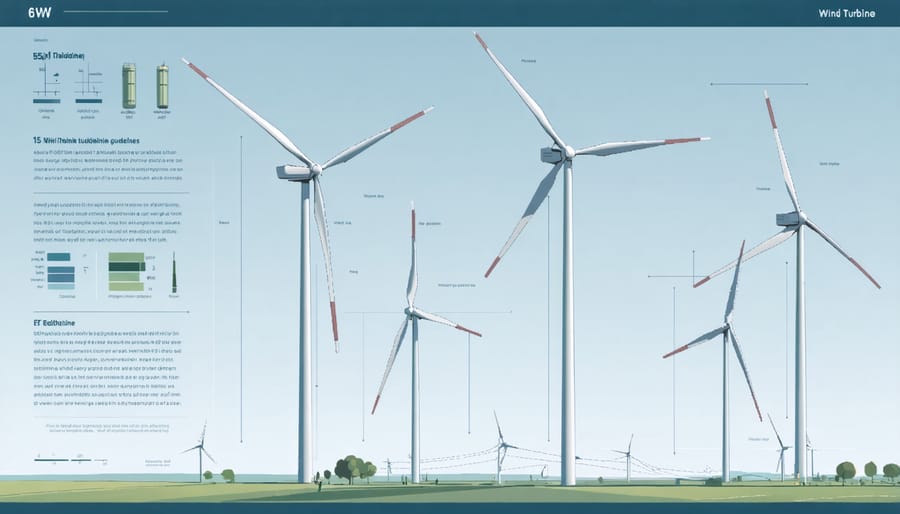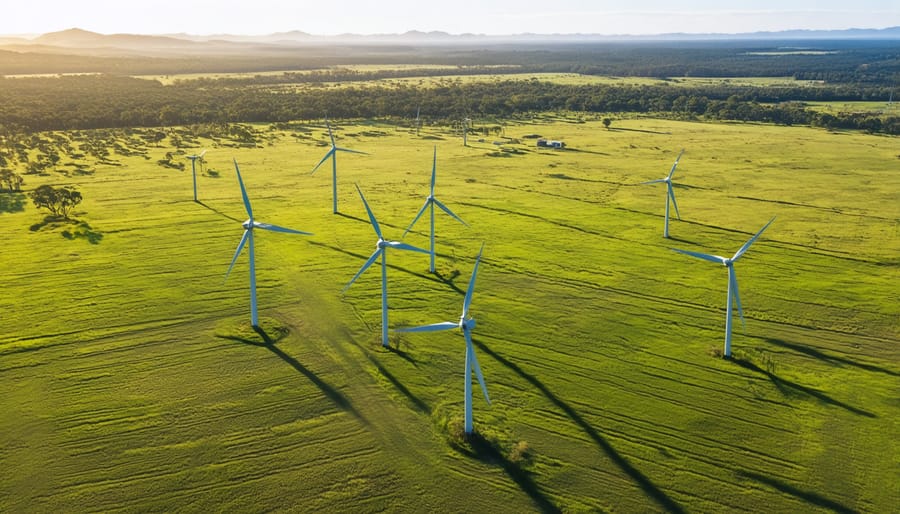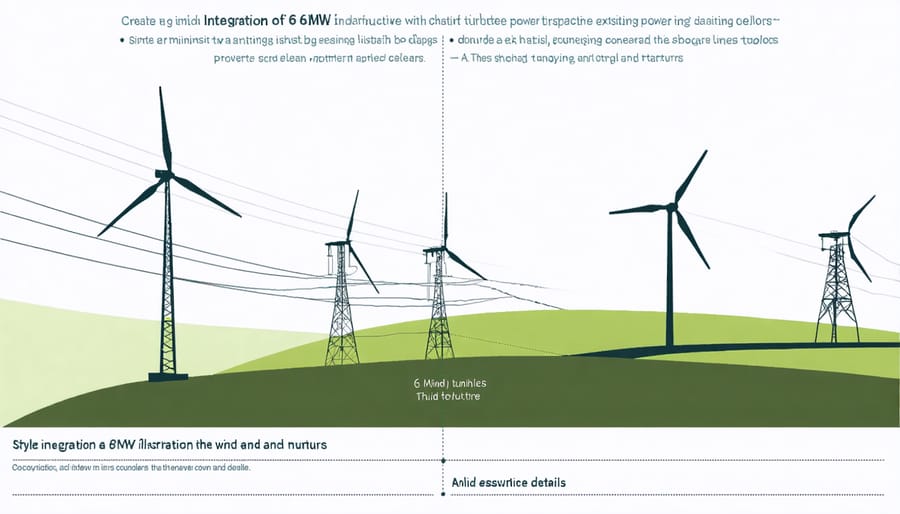Standing at the forefront of revolutionary wind turbine technologies, the 6-megawatt wind turbine represents a powerful leap forward in renewable energy generation. With blades spanning over 150 meters in diameter and towers reaching heights comparable to 50-story buildings, these massive structures generate enough clean electricity to power 5,000 Australian homes from a single installation. As Australia accelerates its transition to renewable energy, these advanced turbines are transforming our coastal winds into an inexhaustible power source, delivering triple the energy output of their conventional predecessors while dramatically reducing carbon emissions. Their sophisticated design, incorporating advanced materials and smart grid integration capabilities, showcases how engineering innovation is revolutionizing our approach to sustainable power generation. For energy providers, developers, and communities seeking robust renewable solutions, the 6MW turbine stands as a testament to what’s possible when we harness nature’s power at an unprecedented scale.
The Power Evolution: Understanding 6MW Wind Turbines
Technical Specifications and Design Features
The 6 megawatt wind turbine represents a marvel of modern engineering, featuring a towering hub height of up to 120 metres and massive rotor blades spanning approximately 150-170 metres in diameter. These impressive dimensions enable the turbine to capture wind energy more efficiently across a larger swept area.
At the heart of the system lies a direct-drive permanent magnet generator, eliminating the need for a traditional gearbox and reducing maintenance requirements while improving overall reliability. The nacelle houses sophisticated control systems and cooling mechanisms that maintain optimal operating conditions even in challenging weather.
The turbine’s innovative blade design incorporates advanced aerodynamic profiles and composite materials, ensuring maximum energy capture while minimizing noise output. Each blade features an intelligent pitch control system that adjusts the angle in real-time to optimize performance and protect the turbine during high-wind conditions.
The foundation system is customizable based on installation location, with options including monopile structures for offshore installations or concrete foundations for land-based sites. Advanced sensors throughout the structure monitor everything from wind speeds to component temperatures, feeding data to smart control systems that adjust operations for peak efficiency.
The turbine’s cut-in wind speed typically ranges from 3-4 metres per second, while reaching maximum power output at approximately 12-14 metres per second. With proper maintenance, these robust machines are designed to operate reliably for 20-25 years, delivering consistent renewable energy to the grid.

Performance Capabilities in Australian Conditions
In Australian conditions, 6 megawatt wind turbines demonstrate remarkable performance capabilities, particularly in coastal and inland regions where consistent wind patterns prevail. These turbines efficiently harness Australia’s abundant wind resources, typically achieving capacity factors of 35-40% in prime locations along the southern coastline and elevated inland areas.
The advanced design of 6MW turbines allows them to operate effectively across Australia’s diverse climate zones. They’re engineered to commence power generation at wind speeds as low as 3 meters per second while maintaining optimal output in the challenging conditions of the outback, where temperatures can soar above 40°C. During peak wind conditions, a single turbine can power approximately 5,000 Australian homes.
What’s particularly impressive is their adaptability to Australia’s variable weather patterns. Sophisticated control systems automatically adjust blade pitch and rotation speed to maximize energy capture during the predictable morning and afternoon wind patterns common across many Australian regions. Even in areas prone to cyclonic conditions, these turbines can weather-vault to protect themselves during extreme events, ensuring longevity and reliable performance throughout their 25-year operational lifetime.
Their cutting-edge monitoring systems also enable precise response to seasonal wind variations, optimizing power output year-round while maintaining grid stability.
Environmental and Economic Benefits

Carbon Emission Reduction Potential
A single 6 megawatt wind turbine can make a substantial impact in reducing carbon emissions, with the potential to offset approximately 13,500 tonnes of CO2 annually – equivalent to taking 2,900 cars off the road. In the Australian context, where coal-fired power plants still contribute significantly to the energy mix, these turbines offer a game-changing solution for our climate goals.
When operating at full capacity, a 6MW turbine can power roughly 5,000 Australian homes, delivering clean energy while preventing the release of harmful greenhouse gases. Over its typical 25-year lifespan, one turbine could prevent more than 337,500 tonnes of carbon emissions from entering our atmosphere.
The environmental benefits extend beyond carbon reduction. Unlike traditional power plants, these turbines require no water for cooling and produce zero direct emissions during operation. This makes them particularly valuable for Australia’s drought-prone regions where water conservation is crucial.
Wind farms utilizing 6MW turbines are already proving their worth. The recently completed Stockyard Hill Wind Farm in Victoria, featuring multiple high-capacity turbines, demonstrates how these installations can significantly contribute to state and national emission reduction targets. For perspective, just ten 6MW turbines can match the annual carbon offset of planting more than 220,000 trees, showcasing their role in Australia’s journey toward a cleaner, more sustainable future.
Cost-Effectiveness and ROI
The financial benefits of 6 megawatt wind turbines present a compelling case for large-scale renewable energy investment. Despite higher initial installation costs compared to smaller turbines, these powerful units deliver superior power generation efficiency and economies of scale that significantly reduce the levelized cost of energy (LCOE) over their operational lifetime.
In the Australian context, 6MW turbines typically achieve payback periods of 5-7 years, with an operational lifespan extending beyond 25 years. The increased hub height and larger rotor diameter enable these turbines to capture stronger, more consistent winds, resulting in capacity factors often exceeding 45% – substantially higher than their smaller counterparts.
For operators, the economics become even more attractive when considering maintenance efficiencies. Despite their size, these turbines require proportionally fewer service visits per megawatt generated, reducing operational costs by up to 30% compared to multiple smaller units producing equivalent power.
Communities hosting these turbines benefit from substantial revenue streams through land lease payments and local job creation. A single 6MW turbine can generate annual returns of $40,000-60,000 for landowners while powering approximately 5,000 homes. Additionally, the increased tax base from these installations often supports improved local infrastructure and services, creating a positive economic ripple effect throughout the region.
Implementation Challenges and Solutions
Infrastructure Requirements
Installing a 6 megawatt wind turbine requires robust infrastructure to support its massive scale and ensure efficient power delivery. The foundation typically consists of reinforced concrete measuring up to 20 meters in diameter and 3 meters deep, using approximately 400-600 cubic meters of concrete. This substantial base is essential for maintaining stability in various weather conditions.
Grid connection infrastructure includes high-capacity transformers that step up the voltage from the turbine’s output to transmission-level voltages, typically 33kV or higher. A sophisticated switchgear system manages power flow and provides essential protection mechanisms. Underground cabling systems, buried at least one meter deep, connect the turbine to the substation.
Access roads must be specially constructed to handle heavy machinery during installation and maintenance. These roads need to be at least 5 meters wide with gentle gradients and reinforced surfaces capable of supporting loads exceeding 100 tonnes. Additionally, the site requires a crane pad area of approximately 40×60 meters to accommodate the large assembly cranes.
Modern monitoring systems, including SCADA infrastructure and weather stations, are essential for optimal performance and safety. These systems require reliable telecommunications connections, often utilizing both fiber optic cables and wireless backup systems.
Installation and Maintenance Considerations
Installing a 6 MW wind turbine requires careful planning and substantial infrastructure support. The process typically begins with detailed site assessment and foundation work, which can take several months to complete. Specialized cranes and transport vehicles are essential for moving the massive components, including the 75-metre blades and nacelle weighing over 70 tonnes.
The installation team must consider local wind patterns, soil conditions, and access routes. Weather windows are crucial, as installation can only proceed during periods of low wind speeds. A typical setup requires a team of skilled technicians working for approximately three weeks, depending on site conditions.
Maintenance is equally crucial for optimal performance. Regular inspections occur quarterly, with major servicing scheduled annually. Teams use advanced monitoring systems and predictive maintenance technology to identify potential issues before they become critical. Key maintenance activities include gearbox oil changes, blade integrity checks, and electrical system testing.
Safety considerations are paramount, with technicians requiring specialized training for working at heights exceeding 120 metres. The turbine’s sophisticated control systems allow for remote monitoring and adjustment, reducing the need for frequent climb-ups.
Overcoming Local Challenges
Australia’s unique environmental conditions present both challenges and opportunities for 6 megawatt wind turbine installations. The country’s vast coastline offers excellent wind resources, but operators must account for cyclone-prone regions in the north and extreme temperature variations across the continent. To address these challenges, turbine designs have been modified with enhanced cooling systems and reinforced structures that can withstand intense weather events.
Local wildlife protection, particularly for birds and bats, has led to the development of sophisticated detection and shutdown systems. These technologies, combined with careful site selection and environmental impact assessments, help minimize interference with native species while maintaining optimal power generation.
Meeting stringent noise regulations in populated areas has driven innovations in blade design and operational controls. Australian operators have successfully implemented adaptive sound management systems that adjust turbine operation based on wind conditions and proximity to residential areas.
Grid integration challenges are being overcome through advanced power electronics and storage solutions, ensuring stable power delivery despite Australia’s sometimes isolated and stretched transmission networks. The implementation of smart grid technologies has proven particularly effective in managing variable wind conditions and maintaining consistent power output.
Future Prospects and Integration
Grid Integration Strategies
Integrating 6 MW wind turbines into existing power grids requires careful planning and sophisticated infrastructure development. Australian grid operators are implementing smart grid technologies and advanced energy storage solutions to manage the variable nature of wind power effectively.
Modern grid integration strategies focus on three key areas: grid stability enhancement, power quality management, and demand-response optimization. Advanced power electronics and real-time monitoring systems help maintain voltage levels and frequency stability, ensuring seamless integration with conventional power sources.
In regions like South Australia, where wind penetration is particularly high, sophisticated forecasting systems are being deployed to predict wind patterns and optimize turbine output. These systems work in conjunction with rapid-response backup generators and interconnectors to maintain reliable power supply.
Grid operators are also implementing innovative load-balancing techniques, including virtual power plant networks that coordinate multiple renewable energy sources. This approach allows for more efficient power distribution and helps minimize transmission losses.
The success of large-scale wind integration is evident in projects like the Lincoln Gap Wind Farm, where multiple 6 MW turbines operate in harmony with the existing grid infrastructure. These installations demonstrate how proper planning and modern technology can overcome traditional integration challenges, paving the way for a more sustainable energy future.

Technology Evolution and Upgrades
The 6 megawatt wind turbine continues to evolve with breakthrough innovations that promise even greater efficiency and output. Recent technological advances focus on smart blade designs incorporating carbon fiber composites, which significantly reduce weight while maintaining structural integrity. These improvements are particularly relevant to Australia’s clean energy transition, where harsh coastal conditions demand robust engineering solutions.
Digital twin technology is revolutionizing turbine maintenance, using real-time data and AI to predict potential issues before they occur. Advanced sensor systems now monitor everything from blade stress to gearbox temperature, enabling predictive maintenance that significantly reduces downtime and operating costs.
Upcoming improvements include hybrid tower designs that combine concrete and steel to reach greater heights, accessing stronger and more consistent wind resources. Engineers are also developing innovative blade heating systems to prevent ice formation in colder regions, while new pitch control mechanisms optimize energy capture across varying wind conditions.
Perhaps most exciting is the development of floating foundations, which will allow 6MW turbines to be installed in deeper waters, dramatically expanding their potential deployment areas. These foundations use advanced stabilization systems and dynamic cable designs that can withstand extreme marine conditions while maintaining optimal power generation efficiency.
As these technologies mature, we’re seeing integration with grid-scale battery storage systems, creating more reliable and dispatchable renewable energy solutions for our growing energy needs.
The 6 megawatt wind turbine represents a significant leap forward in Australia’s renewable energy journey. As we’ve explored throughout this article, these powerful machines are more than just technological marvels – they’re catalysts for transformative change in our energy landscape. With their impressive generating capacity and enhanced efficiency, 6MW turbines are helping to reshape our approach to sustainable power generation.
The potential impact of these turbines on Australia’s clean energy future cannot be overstated. By generating enough electricity to power thousands of homes from a single installation, they’re proving that renewable energy can be both practical and powerful. Their implementation across our windswept coastlines and inland regions demonstrates that Australia is well-positioned to harness this technology’s full potential.
Looking ahead, 6MW wind turbines will play a crucial role in helping Australia meet its renewable energy targets and international climate commitments. The technology’s continued evolution, coupled with decreasing installation costs and improving storage solutions, makes these turbines an increasingly attractive option for large-scale energy projects.
For communities, businesses, and the environment, the benefits are clear. These turbines represent not just clean energy generation, but also job creation, economic growth, and reduced carbon emissions. As more projects come online and our expertise in operating these systems grows, we’re building a stronger, more sustainable energy network for future generations.
The 6MW wind turbine stands as a testament to human innovation and our commitment to environmental stewardship. It’s not just about generating power – it’s about powering progress towards a cleaner, greener Australia.

